| Mary's first contact with embroidery and needlework was while growing up in France.
Her first mother-in-law, Catherine de Medici was very skilled in the art as were
most women in those days of the Renaissance. There are however, no records of Mary
sending such presents to her relatives. Later, as she returned to Scotland to rule,
she would sit at her Council's meetings listening and learn the Scottish ways while
embroidering. But this period of her life was too taken up by duties and trying to
please her people as well as dealing with the various feuds around her, for her to really
spend a lot of time with needlework. During her period of imprisonment at Lochleven,
although she had the time to take up this pastime, she lacked the material which was
grudgingly and parsimoniously sent to her. Therefore, it was not until her captivity
in England that her major works were created. During her first years of
imprisonment, she spent many hours in the company of Bess of
Hardwicke, her jailer's wife, helping her to design new hangings for her properties,
such as the newly-built Chatsworth. Her inspiration was drawn from books such as emblem books, with their Latin double-meaning mottoes, natural history books and fable books, published in France and Switzerland. Mary who was fluent in several languages besides her native Scots and French including Latin, Greek, Italian and Spanish, would have taken pleasure in translating those and playing with the words. The pictures below are some of her most famous works which were put together into a large hanging known as the "Marian Hanging". The hanging contains 37 of these. A lot of these contain some hidden meaning which is explained beside the pictures. The examples below are by no means the only works which Mary filled all those empty frustrating hours. She also made several gifts including a beautiful dress and night coiffes for Elizabeth, riding reins for her son James, bed covers and many more. Click on each one to see a larger version. The following section is reproduced from the book by Margaret Swain "The Needlework of Mary, Queen of Scots". See "Book Review" for more details. |
|
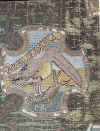
|
"A Byrd of America"
This bird, probably a Toucan can be found in the top left half of the Marian Hanging. Mary would have been inspired by books and accounts of explorer to Brazil and North America. Among Mary's belongings left behind in Edinburgh were an assortment of feathers and a beak from a Brazilian bird. |
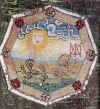
|
Marigold turning to the sun
This octagon is found on the top left edge of the Hanging and bears the Latin inscription: "Non Inferiora Secutus" (Not following lower things). This motto, adopted by Mary as her own, was originally that of Marguerite, sister of Mary's first husband, the French King Francis. Mary changed the motto to "Sa Virtu m'Atire" (Its strength draws me) an anagram of Mary Stuart. |

|
A Phesant
Immediately beneath the previous one is another one of the many birds which Mary probably copied from Gesner's book on natural history. |
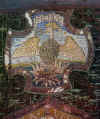
|
Phenix
In the top middle part of the Hanging is a Phoenix rising from the flames. This was the impresa of Mary's mother, Marie de Guise symbolising how she had recreated a new life for herself after being twice widowed. This was to become one of Mary's favourite mottoes: In my End is my Beginning. |
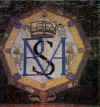
|
Mary Stuart
This octagon is placed immediately beneath the one just mentioned and represents the name Mary Stuart superimposed with the queen's cipher, the royal crown, the thistle and the anagram motto "Sa virtu m'atire". |
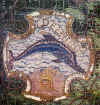
|
Delphine
In the bottom left half of the Hanging appears a dolphin leaping over a crown, an allusion to her first husband, the French King Francis II, also known as the "Dauphin" (dolphin in French). |
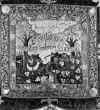
|
The hand and the pruning hook
This is the centrepiece of the Hanging and bears the motto "Virescit Vulnere Virtus" (Virtue flourishes by wounding). It was originally sent by Mary as a gift to Norfolk at the time of their marriage plans and is most certainly intended to be a message to him: the unfruitful branch of the royal house (Elizabeth) was to be cut down, while the more fruitful branch was to be left to produce more fruits. It was indeed the prospect of being the husband of the heiress to the throne of England should Elizabeth die childless (which was likely), which was the incentive for Norfolk. |
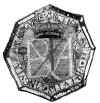
|
Elizabeth Mary
To the right of the centrepiece is an octagon containing the letters of the names Elizabeth and Mary superimposed with a thistle, marigold and another flower at the side. The motto is "Virtutis Vincula Sanguinis Arctiora" (The bonds of virtue are straiter than those of blood). Another allusion to Elizabeth. |
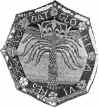
|
Palm tree and tortoise
This octagon is found in the top right half of the Hanging. It is modelled after a coin which was produced during Mary's reign in Scotland and containing the messages: "Expurgat Deus et Dissipentur Inimici Eius" (Arise Lord and scatter thine enemies) and "Dat Gloria Vires" (Glory gives strength).This was a direct insult at Darnley whose sole aim in life was to acquire the Crown Matrimonial. The design represents a tortoise (Darnley) climbing up a crowned palm tree (Mary). |

|
A Catte
This design does not appear in the Hanging but is worthy of notice. It shows a large ginger cat playing with a mouse. A reference to Elizabeth (who had ginger hair) playing with the life of the defenseless mouse (Mary). |